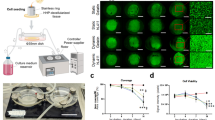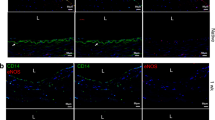Abstract
We have found a novel adhesion receptor on the human endothelial cell for the peptide sequence Arg-Glu-Asp-Val (REDV), which is present in the III-CS domain of human plasma fibronectin, with a dissociation constant of 2.2 × 10−6 M and 5.8 × 106 sites/cell. When a synthetic peptide containing this sequence was immobilized on otherwise cell nonadhesive substrates, endothelial cells attached and spread but fibroblasts, vascular smooth muscle cells, and platelets did not. Endothelial mono-layers on REDV were nonthrombogenic: endothelial cells attached and spread upon other receptor-binding domains of fibronectin and laminin, but with lesser degrees of specificity or with a loss of nonthrombogenicity. This approach may provide a basis for a tissue engineered vascular graft where endothelial cell attachment is desired, but not the attachment of other blood vessel wall cells and blood platelets.
This is a preview of subscription content, access via your institution
Access options
Subscribe to this journal
Receive 12 print issues and online access
$209.00 per year
only $17.42 per issue
Buy this article
- Purchase on Springer Link
- Instant access to full article PDF
Prices may be subject to local taxes which are calculated during checkout
Similar content being viewed by others
References
Yeager, A. and Callow, A.D. 1988. New graft materials and current approaches to an acceptable small diameter vascular graft. Trans. Am. Soc. Artif. Intern. Organs 34: 88–94.
Andrade, J.D. and Hlady, V. 1986. Protein adsorption and materials biocompatibility: a tutorial review and suggested hypotheses. Adv. Polymer Sci. 79: 1–63.
Park, K., Mao, F.W. and Park, H. 1990. Morphological characterization of surface-induced platelet activation. Biomaterials 11: 24–31.
Bennett, J.S., Shatil, S.J., Power, J.W. and Gartner, T.K. 1988. Interaction of fibrinogen with its platelet receptor: differential effects of alpha and gamma chain fibrinogen peptides on the glycoprotein complex. J. Biol. Chem. 263: 12948–12953.
Hawiger, J., Kloczewiak, M., Bednarek, M.A. and Timmons, S. 1989. Platelet receptor recognition domains on the alpha chain of human fibrinogen: structure and analysis. Biochemistry 28: 2909–2919.
Timmons, S., Bednarek, M.A., Kloczewiak, M. and Hawiger, J. 1989. Antiplatelet hybrid peptides analogous to receptor recognition domains on gamma and alpha chains of human fibrinogen. Biochemistry 28: 2919–2923.
Girma, J.-P., Meyer, D., Verweij, C.L., Pannekoek, H. and Sixma, J.J. 1987. Structure-function relationship of human von Willebrand factor. Blood 70: 605–611.
Horbett, T.A., Schway, M.B. and Ratner, B.D. 1985. Hydrophilic-hydrophobic copolymers as cell substrates: effect on 3T3 cell growth rates. J. Colloid Interface Sci. 104: 28–39.
Horbett, T.A. and Schway, M.B. 1988. Correlations between mouse 3T3 cell spreading and serum fibronectin adsorption on glass and hydroxyethylmethacrylate-ethylmethacrylate copolymers. J. Biomed. Mater. Res. 22: 763–793.
Chinn, J.A., Horbett, T.A., Ratner, B.D., Schway, M.B., Haque, Y. and Hauschka, S.D. 1989. Enhancement of serum fibronectin adsorption and the clonal plating efficiencies of Swiss mouse 3T3 fibroblast and MM 14 mouse myoblast cells on polymer substrates modified by radiofrequency plasma deposition. J. Colloid Interface Sci. 127: 67–87.
Dejana, E., Colello, S., Conforti, G., Abbadini, M., Gaboli, M. and Marchisio, P.C. 1988. Fibronectin and vitronectin regulate the organization of their respective Arg-Gly-Asp adhesion receptors in cultured human endothelial cells. J. Cell Biol. 107: 1215–1223.
Dejana, E., Colella, S., Languino, L.R., Balconi, G., Corbascio, G.C., Marchisio, P. C. 1987. Fibrinogen induces adhesion, spreading and microfilamenl organization of human endothelial cells in vitro. J. Cell Biol. 104: 1403–1411.
Massia, S.P. and Hubbell, J.A. 1990. Covalently attached GRGD on polymer surfaces promotes biospecific adhesion of mammalian cells. Ann. N.Y. Acad. Sci. 589: 261–270.
Massia, S.P. and Hubbell, J.A. 1990. Covalent surface immobilization of Arg-Gly-Asp- and Tyr-Ile-Gly-Ser-Arg-containing peptides to obtain well-defined cell-adhesive substrates. Anal. Biochem. 187: 292–301.
Massia, S.P. and Hubbell, J.A. 1991. Human endothelial cell interactions with surface-coupled adhesion peptides on a nonadhesive glass substrate and two polymeric biomaterials. J. Biomed. Mater. Res. 25: 223–242.
Cheresh, D.A. 1987. Human endothelial cells synthesize and express an Arg-Gly-Asp directed adhesion receptor involved in attachment to fibrinogen and von Willebrand factor. Proc. Natl. Acad. Sci. USA 84: 6471–6475.
Dejana, E., Languino, L.R., Colella, S., Corbascio, G.C., Plow, E., Ginsberg, M. and Marchisio, P.C. 1988. The localization of a platelet gpIIb-IIIa-related protein in endothelial cell adhesion structures. Blood 71: 566–572.
Charo, I.F., Bekeart, L.S. and Phillips, D.R. 1987. Platelet glycopro-tein Ilb-IIIa-like proteins mediate endothelial cell attachment to adhesive proteins and the extracellular matrix. J. Biol. Chem. 262: 9935–9938.
Yannariello-Brown, J., Wewer, U., Liotta, L. and Madri, J.A. 1988. Distribution of a 69-kD laminin-binding protein in aortic and micro-vascular endothelial cells: modulation during cell attachment, spreading, and migration. J. Cell Biol. 106: 1773–1786.
Graf, J., Iwamoto, Y., Sasaki, M., Martin, G.R., Kleinman, H.K., Robey, F.A. and Yamada, Y. 1987. Identification of an amino acid sequence in laminin mediating cell altachment, chcmotaxis, and receptor binding. Cell 48: 989–996.
Kleinman, H.K., Graf, J., Iwamoto, Y., Sasaki, M., Schasteen, C.S., Yamada, Y., Martin, G.R. and Robey, F.A. 1989. Identification of a second active site in laminin for promotion of cell adhesion and migration and inhibition of in vivo melanoma lung colonization. Arch. Biochem. Biophys. 272: 39–45.
Humphries, M.J., Akiyama, S.K., Komoriya, A., Olden, K. and Yamada, K.M. 1986. Identification of an alternatively spliced site in human plasma fibronectin that mediates cell type specific adhesion. J. Cell Biol. 103: 2637–2647.
Massia, S.P. and Hubbell, J.A. 1991. An RGD spacing of 440 nm is sufficient for fibroblast spreading and 140 nm for focal contact and stress fiber formation. In revision.
Izzard, C.S. and Lochner, L.R. 1976. Cell-to-substrate contacts in living fibroblasts: an interference reflexion study with an evaluation of the technique. J. Cell Sci. 21: 129–159.
Scatchard, G. 1949. The attractions of proteins for small molecules and ions. Ann. N.Y. Acad. Sci. 51: 660–672.
McGonigle, P. and Molinoff, P.B. 1989. Quantitative aspects of drug-receptor interactions, p. 183–201. In: Basic Neurochemistry, 4th edition. Siegel, G.J., Agranoff, B. W., Albers, R. W., and Molinoff, P. B. (Eds.). Raven Press, New York.
Pytela, R., Pierschbacher, M.D., Ginsberg, M.H., Plow, E.F. and Ruoslahti, E. 1986. Platelet membrane glycoprotein Ilb-IIIa member of a family of arginine-glycine-aspartic-acid specific adhesion receptors. Science 231: 1559–1561.
Beer, J.H. and Coller, B.S. 1989. Immobilized RGD-containing peptides as molecular probes of platelet gpIIb/IIIa receptors. Thromb. Haemostas. 62: 341 (abst).
Jaffe, E.A., Nachman, R.L. and Becker, C.E. 1973. Culture of human endothelial cells derived from umbilical cord veins. J. Clin. Invest. 52: 2745–2757.
Desai, N.P. and Hubbell, J.A. 1991. A solution technique to incorporate polyethylene oxide and other water soluble polymers into surfaces of polymeric biomaterials. Biomaterials In press.
Akiyama, S.K. and Yamada, K.M. 1985. The interaction of plasma fibronectin with fibroblastic cells in suspension. J. Biol. Chem. 260: 4492–4500.
Hubbell, J.A. and McIntire, L.V. 1986. Technique for visualization and analysis of mural thrombogenesis. Rev. Sci. Instrum. 57: 893–897.
Desai, N.P. and Hubbell, J.A. 1989. The short-term blood biocom-patibility of poly(hydroxyethyl methacrylate-co-methyl methacrylate) in an in vitro flow system measured by digital videomicroscopy. J. Biomater. Sci. Polymer Edn. 1: 123–146.
Author information
Authors and Affiliations
Rights and permissions
About this article
Cite this article
Hubbell, J., Massia, S., Desai, N. et al. Endothelial Cell-Selective Materials for Tissue Engineering in the Vascular Graft Via a New Receptor. Nat Biotechnol 9, 568–572 (1991). https://doi.org/10.1038/nbt0691-568
Received:
Accepted:
Issue Date:
DOI: https://doi.org/10.1038/nbt0691-568
This article is cited by
-
Design of selective cell migration biomaterials and their applications for tissue regeneration
Journal of Materials Science (2021)
-
Polymeric Biomaterials for Scaffold-Based Bone Regenerative Engineering
Regenerative Engineering and Translational Medicine (2019)
-
Tethering QK peptide to enhance angiogenesis in elastin-like recombinamer (ELR) hydrogels
Journal of Materials Science: Materials in Medicine (2019)
-
Biomaterial-mediated strategies targeting vascularization for bone repair
Drug Delivery and Translational Research (2016)
-
Peptide immobilization on polyethylene terephthalate surfaces to study specific endothelial cell adhesion, spreading and migration
Journal of Materials Science: Materials in Medicine (2012)



